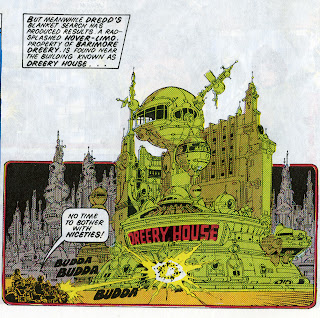Thursday, October 18, 2012
Mega City One
Mega City One is the setting for the story of Judge Dredd. The story takes place 122 years in the future after a nuclear war. Most of the world has been turned to desert and people flock to cities for refuge. Mega City One takes up the entire east coast from Boston to Charlotte.
One interesting tid-bit is that the strip started in 1977 and has progressed foward at real time, so Dredd has actually aged 33 years since his creation.
The world of Mega City One is one of over population - The population for the city stands at 400 million people (for comparison New York population is around 8 million), with each apartment block housing 50,000+, although a large percentage of the population are nomadic due to housing provisions.
Housing Blocks are considered small towns, each typically having a hospital, gymnasium, school and shopping district. There really is no need to ever leave your block.
The majority of work is carried out by machines and robots which lead to unemployment and boredom, due to this and the loyalty that individuals have for their block there are rampant Block Wars. The blocks are usually named after famous people of historical figures, usually it is something that is currently in the media. Examples are Nicole Kidman Block at war with Tom Cruise Block, Andy Warhol Block at war with Jackson Pollack Block. This seems to be slightly silly, and it partially is, but the topics the strip covers are also hot button topics that are in media (politics, obesity, over-population, technology). The writers just amplify and exaggerate these contemporary events.
Notice the numerous methods of transportation throughout the city.
Unlike Batman, Daredevil, and Superman, Judge Dredd's personality does not match his environment. Mega City One is exhuberant, unrestrained, and slightly absurd, while Judge Dredd is rigid and has somewhat of a monotonous outlook, but notice how different each Block is represented, how each block has developed it's own personality for the residents that live there.
Pat Mills and John Wagner credit the cities original aesthetic of soaring organic architecture to Eero Saarineen and the British Motorways of the 60's and 70's.
Subscribe to:
Post Comments (Atom)








No comments:
Post a Comment